
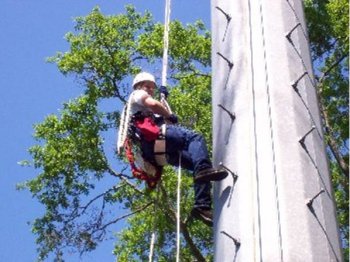
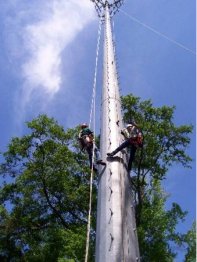
*Tower Rescue: When Things Go Bad*
I watched Tower Dogs on Dateline NBC tonight which made me think I should write this.
Tower work is an extremely dangerous and deadly job. Not just for us people that go hundreds of feet in the air, but even for the person who only climbs up on a little 30í tower. However it doesnít need to be as deadly as it is. Statistics show that the majority of the falls are because the climber was not properly tied off to the tower. Some climbers free climb meaning they are not attached at all while moving around. Other climbers fail to 100% tie off because ďIím just moving over thereĒ and they think because theyíre holding on to the tower that they are safe. What happens if they arenít attached and their grip slips for whatever reason? Gravity still works. In this game you are EXTREMELY lucky to get a second chance to screw up.
When I climb I am always attached to the structure at least once. It could be with a positioning lanyard, cable grab, shock absorbing lanyards or self retracting lanyard. When I stop during an ascent or descent I attach twice. Both with a fall arresting lanyard and a positioning device. Once I am in position to work on something I am often times attached to the tower THREE ways at 3 different points on the tower. In the event I fall itíll take that many equipment failures for me to go whizzing to the ground.
So letís say that a climber is properly tied off and falls. The end result will be the person hanging from a D ring on the back of the harness. Itís a pretty good bet that they will be injured one way or another even if they donít hit anything during the fall. Somebody on the ground should be calling EMS and getting an ambulance on scene ASAP! If you look at the monopole, youíll see the climbing pegs. They are carriage bolts actually and even through they have a big head on them, if a person falls and hits them they WILL get torn up.
NOTE: Body belts!! BAD BAD BAD!!! Some people will climb with nothing more than a belt around their waste with the mindset of ďIf I fall it will hold meĒ. Yea, okÖ it WILL hold you provided you donít slip right through it, but then what? If you attach a fall arresting lanyard to the front or side of the belt, you will fall and break your back when it fetches up. If you attach to the back of the belt you will fall and double over and kiss your feet. Thatís not the bad part. The bad part is this belt is going to be pulling up toward your chest and jam up under your rib cage. Gravity is pulling your body down, the belt ainít going anywhere. So whatís happening is your diaphragm is being forced upward. This means it wonít be functioning and causing your lungs to suck in air, which in turn means you wonít be breathing, which means youíre going to suffocate while hanging there helpless. THAT has been proven. Body belts are still manufactured and sold, but are illegal to use in the tower industry. That is why. Although it will probably keep you from going splat, it will kill you in a couple of minutes. Without oxygen brain damage starts in about 4 minutes, serious brain damage in 6 and after 10, youíre really toast. Nobody will be able to save you in that amount of time. Even trained professionals can take 20 minutes minimum to get to an injured climber, then rig to them and get them on the ground. 20 minutes is provided all of the rescue equipment is in place. Without the equipment in place, it could be an hour or more.
On to the article-
Last spring the tower company I was working for hired on 2 new guys so we did some rescue training. We did it on a 150í monopole. We did all training at about 40í just so we didnít have to keep climbing up so high over and over again.



Me on a Fisk descender---------------------------------------Me with my victim (Iím on right)
Above the victim is getting ready to hang from his harness and await rescue.
So a climber falls and becomes suspended by the back D ring. They are facing the ground and might be injured, bleeding, or unconscious. Possibly all or more.
Hereís whatís happening below. I have fallen on the monopole and am suspended by the D ring on my back (which I actually am). My rescuer is descending from above and works his way behind me. When his pelvis area hits the same height as my D ring he stops and ties off his descending device. This allows him to have both hands free. In this case we were using a Fisk descender. He will then rig my D ring to the karabiner between his harness and the Fisk descender. This will give him control of me while not putting any additional weight on him. My weight is transferred directly to the descent device. Once the victim is secured, the rescuer will roll them around on to their hip. This keeps the victim out of the way so that the rescuer can work the ropes and descend both of us. Now the last thing to do is for the rescuer to cut whatever the victim is suspended by. Once that is cut the rescuer OWNS the victim.
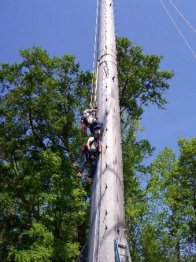
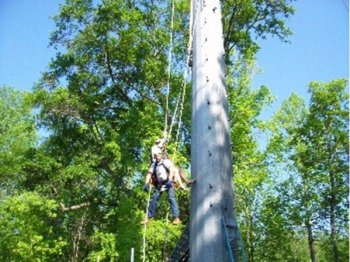
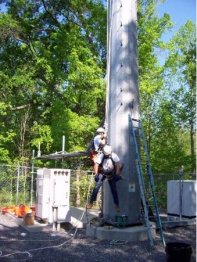
Me hanging---------------------Rolled on his hip------------------------Coming down
Even with the additional weight, by using a Fisk descender the rescuer can EASILY control the descent.
As the pair reaches the ground most likely the victim is going to collapse to the ground. The best thing for the rescuer to do is to lay down with them. This gives enough slack to be able to disconnect from their harness.
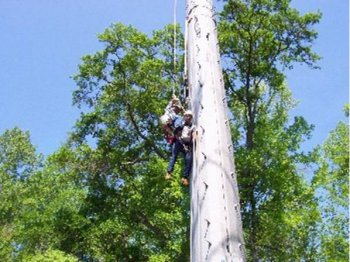
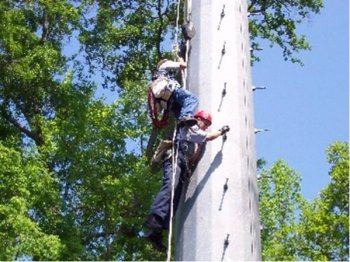
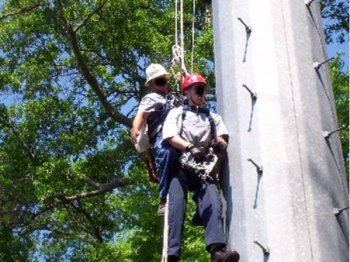
Me awaiting rescue-------------------------Rescuer coming down----------------------------In position
Notice in the right picture how the chest strap is up at his throat. That is with the harness properly fitted to him.
Tower work is a dangerous game. If you watched the Dateline show you saw where Ernie was getting paid $14.00 per hour. Thatís about right, thatís what I was paid with 3 years of experience. For all the risk involved itís hard to make a living doing it. So when you drive by and see somebody up on a tower and start thinking about how much money they make, think again.
Jaden
www.alpharubicon.com
All materials at this site not otherwise credited are Copyright © 1996 - 2008 Trip Williams. All rights reserved. May be reproduced for personal use only. Use of any material contained herein is subject to stated terms or written permission.